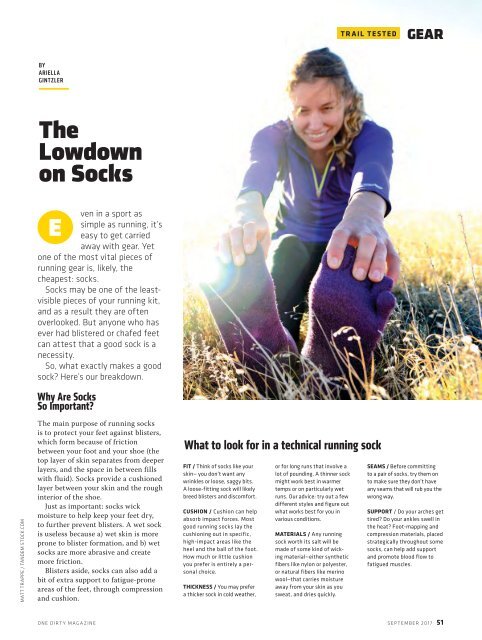Create successful ePaper yourself
Turn your PDF publications into a flip-book with our unique Google optimized e-Paper software.
TRAIL TESTED<br />
GEAR<br />
BY<br />
ARIELLA<br />
GINTZLER<br />
The<br />
Lowdown<br />
on Socks<br />
MATT TRAPPE / TANDEM STOCK.COM<br />
E<br />
ven in a sport as<br />
simple as running, it’s<br />
easy to get carried<br />
away with gear. Yet<br />
one of the most vital pieces of<br />
running gear is, likely, the<br />
cheapest: socks.<br />
Socks may be one of the leastvisible<br />
pieces of your running kit,<br />
and as a result they are often<br />
overlooked. But anyone who has<br />
ever had blistered or chafed feet<br />
can attest that a good sock is a<br />
necessity.<br />
So, what exactly makes a good<br />
sock? Here’s our breakdown.<br />
Why Are Socks<br />
So Important?<br />
The main purpose of running socks<br />
is to protect your feet against blisters,<br />
which form because of friction<br />
between your foot and your shoe (the<br />
top layer of skin separates from deeper<br />
layers, and the space in between fills<br />
with fluid). Socks provide a cushioned<br />
layer between your skin and the rough<br />
interior of the shoe.<br />
Just as important: socks wick<br />
moisture to help keep your feet dry,<br />
to further prevent blisters. A wet sock<br />
is useless because a) wet skin is more<br />
prone to blister formation, and b) wet<br />
socks are more abrasive and create<br />
more friction.<br />
Blisters aside, socks can also add a<br />
bit of extra support to fatigue-prone<br />
areas of the feet, through compression<br />
and cushion.<br />
What to look for in a technical running sock<br />
FIT / Think of socks like your<br />
skin— you don’t want any<br />
wrinkles or loose, saggy bits.<br />
A loose-fitting sock will likely<br />
breed blisters and discomfort.<br />
CUSHION / Cushion can help<br />
absorb impact forces. Most<br />
good running socks lay the<br />
cushioning out in specific,<br />
high-impact areas like the<br />
heel and the ball of the foot.<br />
How much or little cushion<br />
you prefer is entirely a personal<br />
choice.<br />
THICKNESS / You may prefer<br />
a thicker sock in cold weather,<br />
or for long runs that involve a<br />
lot of pounding. A thinner sock<br />
might work best in warmer<br />
temps or on particularly wet<br />
runs. Our advice: try out a few<br />
different styles and figure out<br />
what works best for you in<br />
various conditions.<br />
MATERIALS / Any running<br />
sock worth its salt will be<br />
made of some kind of wicking<br />
material—either synthetic<br />
fibers like nylon or polyester,<br />
or natural fibers like merino<br />
wool—that carries moisture<br />
away from your skin as you<br />
sweat, and dries quickly.<br />
SEAMS / Before committing<br />
to a pair of socks, try them on<br />
to make sure they don’t have<br />
any seams that will rub you the<br />
wrong way.<br />
SUPPORT / Do your arches get<br />
tired? Do your ankles swell in<br />
the heat? Foot-mapping and<br />
compression materials, placed<br />
strategically throughout some<br />
socks, can help add support<br />
and promote blood flow to<br />
fatigued muscles.<br />
ONE DIRTY MAGAZINE SEPTEMBER <strong>2017</strong> 51




